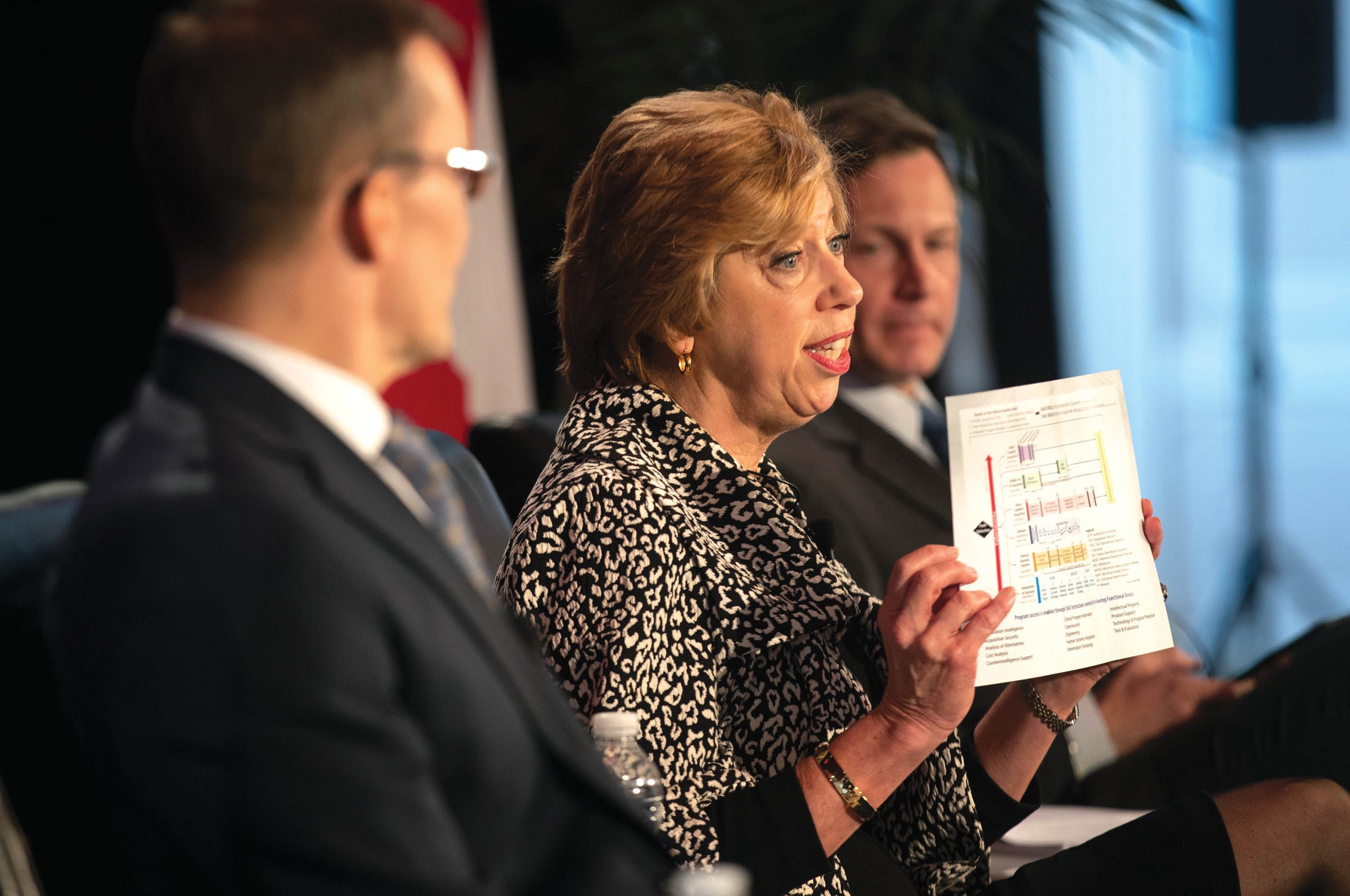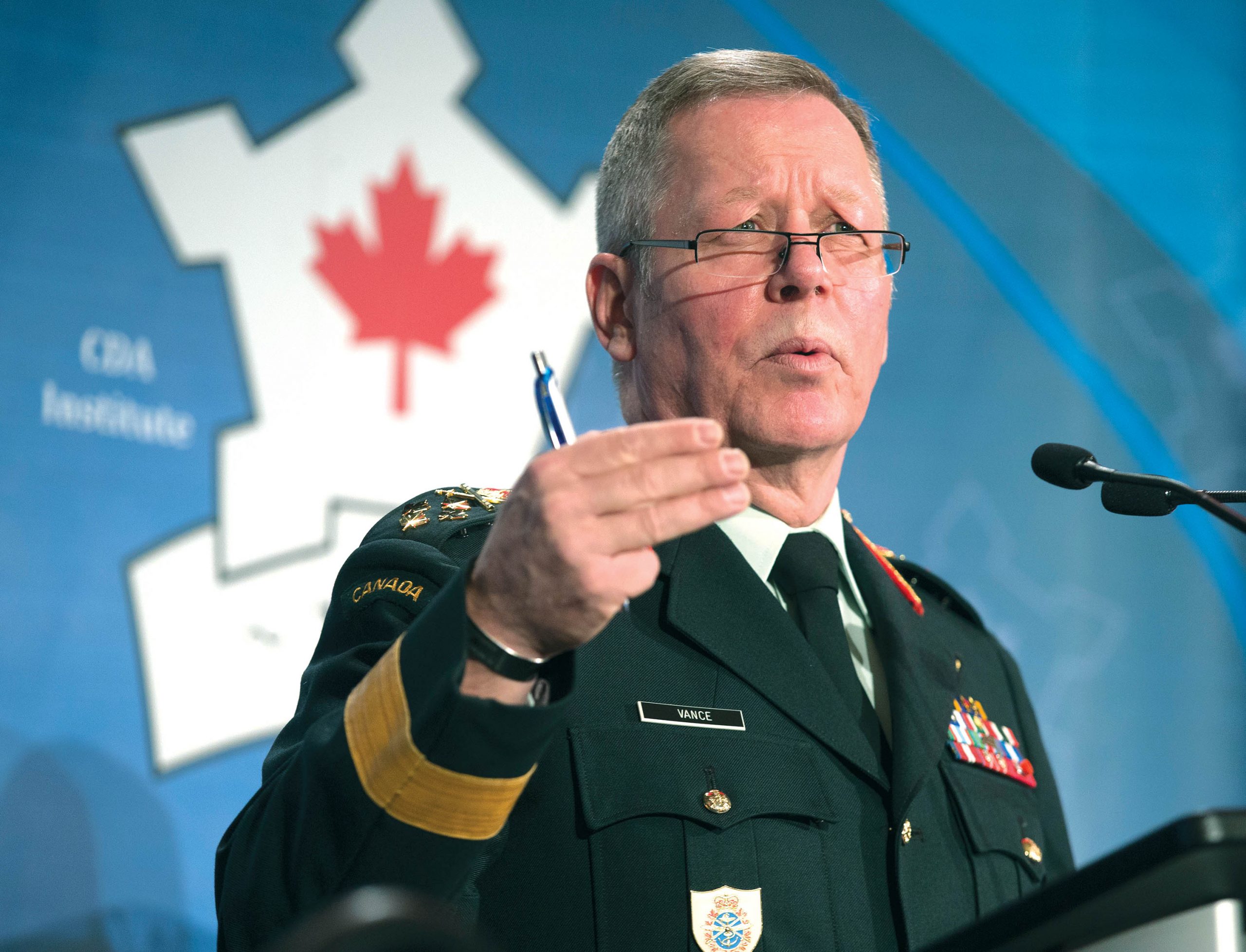
Ellen M. Lord, U.S. undersecretary of defence for acquisition and sustainment, and retired U.S. rear-admiral Grant J. [Stephen J. Thorne]
China and Russia were front and centre at the annual Ottawa Conference on Security and Defence on March 4-5, where experts lined up to condemn the two superpowers for everything from their aggression and spying to their destabilization efforts and treatment of minorities.
“So long as there are nations provocatively developing offensive military capabilities in all domains with the intent to use them to underwrite aggressive economic and social behaviour, there is a risk of escalation to high-intensity regional or global conflict,” said the chief of the defence staff, General Jonathan Vance. “That would be devastating for all parties involved and must be prevented.”
Russia annexed Crimea and invaded Ukraine, he noted. Its air force regularly flies close to the sovereign airspace of other nations—it did so off the coast of Alaska on March 9, just days after he spoke. Russia conducts disinformation campaigns to advance its agenda.
Chinese aggression in the South China Sea is undermining regional stability, he added. It employs “coercive” economic and diplomatic practices and it is attempting to compromise Canada and its allies through its cyberspace activities.
“They have both demonstrated that they possess the military force, with its latent threat, combined with the political will, to achieve destabilizing effects to their ultimate advantage,” Vance told the gathering, hosted by the Conference of Defence Associations Institute. The think tank’s members include military and veterans organizations of which The Royal Canadian Legion is the largest member.
“These below-the-threshold activities are a death by a thousand cuts. In isolation, they would not merit large-scale responses. But viewed cumulatively, it is clear that they demand a new approach.”
Vance cited NATO deterrence efforts in eastern Europe, including air patrols, the Canadian-led mission in Latvia and other alliance missions across the vulnerable Baltic region.
The Canadian-American air defence system, Norad, needs upgrading, he acknowledged, and soon.
“The missile threat to North America is growing more complex,” he said. “North America is no longer dealing with the threat of ballistic missiles alone. We’re facing more advanced conventional missiles that can be launched from farther away, travel faster, and are more manoeuvrable.
“Most importantly, they have the potential to hold North American decision-making hostage in a period of conflict, let alone threaten our force generation capacity and critical infrastructure. Even a modest attack could hamper or cripple Canadian response to crisis or harm Canadians or critical infrastructure.”

The chief of the defence staff, General Jonathan Vance (left, pictured in 2019), told the conference that nations developing offensive military capabilities put global peace at risk. [Stephen J. Thorne]
Relations between Canada and China, particularly, have been strained since December 2018, when Canadian authorities arrested Huawei executive Meng Wanzhou over the United States’ allegations the company violated sanctions on Iran.
Wanzhou has remained under house arrest in Vancouver while her extradition case is before a Canadian court. Two Canadians have since been detained in China on national-security allegations.
China’s ambassador to Canada, Cong Peiwu, appeared on a panel at the two-day conference, where delegates gave him a grilling on several issues, including the fate of the Canadians, Michael Spavor and Michael Kovrig.
Cong insisted the pair are being treated fairly under Chinese law. But he would not say when his country will produce evidence to back up its claims that they are spies.
The ambassador insisted detention camps housing up to a million ethnic Uyghurs in western China are nothing more than “vocational training centres,” despite overwhelming evidence to the contrary. And he suggested cool relations between Canada and China are warming due largely to Ottawa’s measured response to the coronavirus pandemic, which originated in the commercial centre of Wuhan.
Canada and other allies have come under increasing American pressure to prevent Chinese telecom giant Huawei from installing its 5G network. It claims the technology will be used as a Trojan Horse to undermine national security and global security alliances such as the Five Eyes—Canada, Britain, Australia, New Zealand and the United States.
U.S. national security adviser Robert C. O’Brien told a conference in Halifax in November that, if allowed to install its 5G network in Canada, Huawei is “going to know every health record, every banking record, every social media post—they’re going to know everything about every single Canadian.”
He said Beijing could use data mined from its 5G network to “micro-target” Canadians with personalized texts aimed at influencing elections and he said such an intrusion could affect Canada’s role in the Five Eyes alliance.
“The Huawei Trojan Horse is frightening, it’s terrifying,” he said. “I find it amazing that our allies and friends in other liberal democracies would allow Huawei in.
I’m surprised that there’s even a debate out there.”
Vance knows the issues well. Before the Department of National Defence began its move from downtown Ottawa into the former Nortel premises in suburban Kanata, Ont., technicians removed dozens of electronic eavesdropping devices. They are believed to have been Chinese.
Documents obtained several years ago by the Ottawa Citizen revealed that the eventual headquarters of 8,000 defence employees has been the target of industrial espionage for almost a decade. An internal security study by Nortel suggested that hackers had downloaded research and development studies and business plans as far back as 2000. The hackers also placed spyware into some employee computers.

McDonald, the former head of Norad cyber security, warned that China is infiltrating American and allied industry for its own gain. [Stephen J. Thorne]
Ellen Lord, U.S. undersecretary of defence for acquisition and sustainment, told the conference that Chinese exchange students attending American universities are clearly “taking the intellectual property back to China for nefarious reasons.”
“We start tracing back and
finding out that U.S. government dollars are funding research that then is going right back to China and being used against us. This is…a huge, huge problem.”
Lord, the former CEO of Textron Systems, a global aerospace, defence, security and advanced technologies conglomerate, said American industry is deeply dependent on Chinese labour and products.
She said China has “very clearly articulated” what areas of the marketplace and technology it plans to dominate by 2025.
“And it’s not through investing in education and research solely in China,” she warned. “They are at war with the world to get intellectual property and capability by any means whatsoever.”
She described the concept of “adversarial capital,” saying Chinese money has acquired U.S. businesses with technology that is “absolutely critical to our national defence.”
“And it comes in not through ‘ABC Chinese Company.’ It comes in through shell companies many, many, many layers down.”
A U.S. Treasury Department committee was formed several years ago to review acquisitions and recommend measures to mitigate potential threats or block sales altogether. New rules aim to vet capital providers, such as venture capitalists and investment banks as well as small companies, to ensure their money is clean.
In a panel on the issue of cybersecurity and critical infrastructure, retired U.S. rear-admiral Grant J. McDonald, Norad’s former director of cyberspace operations, said cyberspace “is literally 360 degrees and moving at the speed of light.”
All it takes, he says, is a smartphone, a laptop or a computer to breach a network, he said.
Planners, therefore, have to build security into the network and the architecture and the devices that will run on that architecture—both software and hardware.
Then security must be built into the apps that will run on the devices that run on the networks.
“We’ve got to think holistically about the defence of cyberspace and our networks,” said McDonald.
The biggest piece authorities have to grasp is what he called “the people part,” emphasizing that 80 to 90 per cent of compromises are due to people doing boneheaded things, such as mistakenly clicking on compromising links and visiting unauthorized websites.
At the other end are nation states, rogue nations, criminal organizations, organized crime, terrorists, state-sponsored terrorism, “and anybody who’s at home and just wants to do something bad.”
“The threat is all around us,” McDonald emphasized. “Everything that we do now is part of cyberspace. How we live our lives now is through these devices—pay our bills, we bank, we do everything on [them].
“So, we’ve got to just think differently about how we defend and how we secure our networks—and our lives…and I would argue that my personal information is just as valuable to me as classified material is to the defence department.”
Advertisement





















